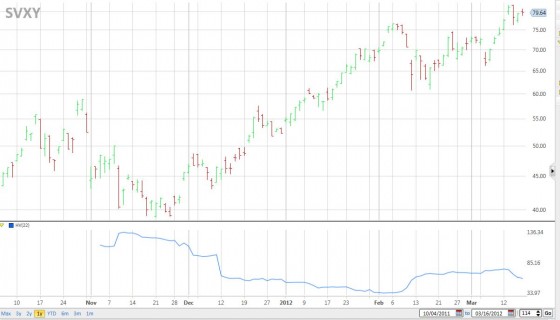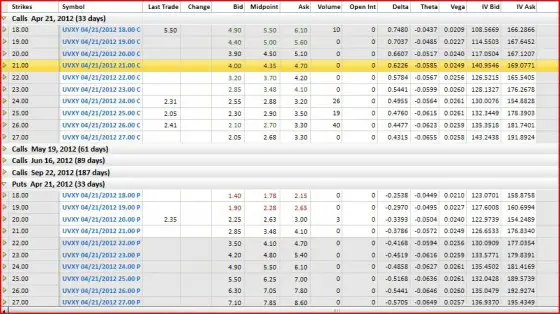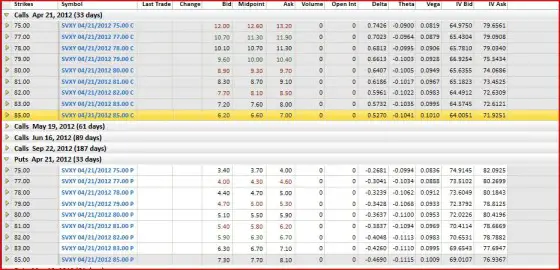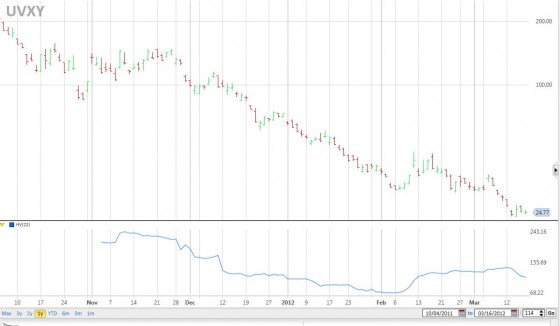If things weren’t derivative enough for you before, you can add one more level of indirection to your volatility investments.
Options are available on ProShares‘ 1.5X VIX short-term UVXY and their -0.5X inverse short-term SVXY. These options are similar to VXX’s options; they are American exercise style and expire on the same day as equity options. VIX options are European exercise and expire on the same day as VIX futures.
These options aren’t cheap. Volatility funds are themselves volatile, which drives the premiums higher. The charts below show the historical 22 day volatilities (HV) of UVXY and SVXY.

The option chains below show typical prices.


The market makers are pricing the IVs at around 110 (UVXY) and 35(SVXY). In comparison, April ATM VIX options are carrying an IV of around 65 and VXX ATM options have an IV of 40. UVXY’s option IVs have to be some of the highest ones around… These options are expensive, and their bid/ask spreads are wide, but options open up a whole host of interesting strategies. If you do trade these products, limit orders are a must. You can probably get fills close to mid-way between the bid and ask prices.


Vance,
what is your opinion on in the money covered calls? I.E. buying SVXY at 85 and selling a call with a 69 strike while the current market price is at 96. The call premium is 31 and dated 10 months out. This would provide a downside breakeven price of 65 or 32% downside protection. I know the risks include the VIX spiking 80% in one day and the NAV approaching 0 would most likely cause the ETF to close. At least the call premium is pocketed in the worse case. If the price stays above strike then you would still net $1417 which is 16%. The max loss in a black swan event would be
$5483 or 64%. Yes, not for the faint of heart, or large portion of the portfolio. Your thoughts?
HI Chris, Not sure I understand your setup, but if you bought at 85 and the current market price is 96 you already have a 12.9% gain. Selling an S69 call at that point only nets you an additional $4 in premium (96-69 = 27, call price is $31). So you are only gaining another 4% tying up your money for another 10 months and you’ve given up most of the upside on your SVXY position (best case gain is $4/share). If your goal is to protect your current profit even during a substantial drawdown (-32%) while giving yourself another 4% upside it would seem to be a good trade.
Vance, love the blog. Question for you. Have you ever done a study on future “volatility of volatility”, i.e., VVIX. Does volatility of volatility tend to be in either contango, backwardation, or neither?
Hi Tom, Thanks for the feedback, I appreciate it! Regarding the term structure of vol of vol, I haven’t done a study. A quick look at ATM VIX option IVs showed that the Vol of vol term structure is currently pretty flat. The realized vol of the further out VIX futures is definitely lower, so if the vol of vol term structure is generally flat that suggests the risk premium (difference between realized and implied volatility) goes up with time.
— Vance
I trade VXX puts mostly. I could be persuaded to look at UVXY puts, but they are far too expensive.
Do you think the IV will fall when the market becomes more liquid?
Also, any thoughts on the $2 billion AUM for VXX these days? I was surprised, given how much of a beating VXX has been taking. Maybe this explains the contango in VIX futures. A $2 billion fund has to have some impact on the term structure.
Hi Andrew, Unless the historic volatility of UVXY drops I don’t think we’ll see much drop in the IVs. I haven’t tried to buy any of the options, but I suspect that you might get fills pretty close to the mid price.
The open interest on volatility funds tends to climb during long bull runs and drop when the corrections happen. I think the increased popularity of volatility as an asset class is showing in these AUMs. Jared from Condor Options has done some good work on whether VXX et all is disturbing the overall market and he sees no sign. Two billion relative to what is the question.
— Vance